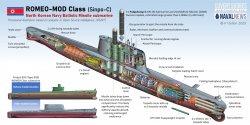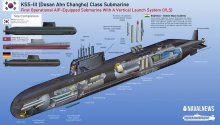Just speaking from my own (comparatively limited) experience specifically dealing with USW CONEMPs, their largest contribution is achieved by operating in the blue waters between the 1IC and 2IC. This is especially true if the PLAN pursues SL(ASh)BMs roughly similar to our own I-CPS procurement (which we know is, at a minimum, being seriously explored). Relevant to that, we are expecting future PLAN SSNs to host a new, relatively large VLS/CLS system to employ these new munitions, which aligns with prior talk from the grapevine about a 1.2 meter diameter, 1500nm-class range AShBM being developed by the PLAN.
...
This kind of "big picture" (I don't know a better definition) analysis is what is sorely lacking from internet discussions. For example this post changed my mind about sub fired land attack missiles. It seems forcing the adversary to re-orient their air defense assets in a way that is less optimal to counter your main vector of operations is their main utility.
...
Why not lol? We have sooo much critical military infrastructure and personnel at those spots, not to mention the CRUDES buffet. Frankly I can't think of many things more relevant to shoot at in a naval war than... well... the enemy navy's defenseless single-points-of-failure. You can be sure that if we were able to destroy/disable the bulk of the PLAN Surface Force once hostilities commence, and could do so with a relatively minor effort, that we would jump on it faster than Saddam Hussein can say " ".
...
For the cost of 1 apple you might buy 2 oranges.
...
This is a gargantuan oversimplification. Not all procurement matters are a simple function of how much a system costs.
...
I do apologize for the way I quoted each of your posts, but I have to shorten the quoted posts as they are (mostly) very long, which would eat up the number of alphabets that are allocated per post in this forum.
But let's get to the point.
The very features of making an SSN viable as a naval warfighting platform -
quietness, stealthiness, and the ability to disappear and reappear at any time the captain desires - Pretty much grant SSNs certain levels of immunity when compared to the likes of surface warships.
For a surface warship, the only time you can really hide from detection by enemy satellites and aerial units is when a surface warship got converted into a submarine (just like Moskva /s). Submarines, no matter whether big or small and whether conventional or nuclear powered, can easily submerge beneath the waves and grant themselves "invisibility" for reconnaisance and spying assets up above.
Even for the US Navy and their allies with the best ASW capability in the world,
the oceans are massive, massive places.
Neither China nor the US+allies can deploy enough warships to scout and monitor every single piece of the oceans across the world.
Neither China nor the US+allies can build enough warships to allow that.
Hell, not even the industrial might of the US in WW2 can prevent I-58 from sinking the USS Indianapolis, despite having full sea-based and air-based superiority around Japan at the time of the sinking.
To simply put,
ASW capabilities of today is still rather limited in terms of scope and size of coverage relative to the ranges of offensive weapons that can be deployed onboard submarines of today.
This is where SSNs armed with long-range strike missiles come in. Their
stealthiness and
invincibility (
under certain conditions) allow the SSNs to sail pretty much anywhere around the world, plus having
huge degree of flexibility in situations where surface warships could only ever dream of.
Just like
@Patchwork_Chimera has implied - The massive increase of the 093+039A+093B+095 SSNs in the coming years would premit the PLAN enough flexibility such that their
onboard long-range strike missiles can be launched against targets on Guam, Wake and possibly even Oahu from
locations that the US military stationed on those islands could not always expect for - and -
from directions that those defensive units on those islands could not always prepare in-advance for.
Sure, one could just say that a 055 can do the same with more missiles onboard than a 093B. But you can guarantee that the US military would definitely track and chase down the 055 as soon as she is spotted sailing in the direction of these islands. This is not yet mentioning the fact where the PLA have very little means of providing cover and protection for the 055 operating that far out into the Pacific, whether that be from allied warships, carrier-based aircraft, plus land-based missiles and land-based aircraft.
Besides, there is also the flexibility offered by SSNs in terms of
range and
usage of weapons against targets at different ranges.
Of course, all of us can dream that China should just pump out DF-41s like sausages (/s Khruschev), and that China could just launch unlimited number of DF-41s towards its targets across the globe when the PLA CMC points towards a direction and said "I order you to fvck everything in that general direction".
However, realities can be far more daunting than dreams.
Let's say that printing DF-17s in the thousands by taking advantage of its cheap manufacturing cost allows the PLA to strike targets as far out as (estimated) 2500 kilometers away.
But that's only 2500 kilometers away. Both
Guam and
Diego Garcia is
more than 4000 kilometers away. So what's the use of printing more cheap DF-17, if all of them would only fall into the water instead of falling onto Andersen AFB and NSF Diego Garcia?
Therefore, if you want to strike Guam and Diego Garcia, then you have to use Dongfengs with longer range than the DF-17, i.e. DF-26.
But what about
Wake,
Oahu and
Darwin? Then you need Dongfengs with even longer ranges than the DF-26, i.e. DF-31.
Problem is -
As missiles get bigger and longer range, the associated costs also add up significantly.
In fact, it is claimed that one
DF-26 costs around
100 million RMB, or
14.6 million USD; and one
DF-31 is alleged to cost around
205 million RMB, or
30 million USD. Perhaps those numbers could even be on the lower end of the available guesstimates.
Compare those two with the
DF-17's known price tag of
2 million USD. Notice how the costs for each successive missiles have risen? Even if the upcoming
DF-27 with a 5000-8000 kilometer range can have its price tag reduced somewhat - If the boost-glide vehicle of the DF-27 is based upon the rocket booster of the DF-26 - then DF-27 can also be rather expensive.
I don't think that the August 1st building have infinite budget and unlimited materials for them to print DF-27s just as how they print DF-17s. This is why the PLA is procuring mediums and platforms that would deliver missiles and bombs further out from China's maritime and land borders, so that they wouldn't have to rely upon the PLARF to do all the heavy lifting. This is why China is procuring VLO strategic bombers i.e. H-20, large destroyers/cruisers i.e. 055, and nuclear-powered attack submarines i.e. 093B.
Sure, every single unit of the H-20, 055 and 093B is way more expensive than a DF-17 or a DF-26 plus their TEL launchers. But, consider this: Once a DF-17 or DF-26 is launched from a TEL, it has to go back to base or nearest depot to reload another missile before launching again. The associated costs of setting up and maintaining those have been generally explained by
@Patchwork_Chimera, so I won't go deep into it.
Furthermore, there is also the fact where
one TEL could
only launch one DF-17 or
DF-26, but
one H-20, 055 or 093B can
launch multiple YJ-18s or YJ-21s. I couldn't find any information regarding the unit price of YJ-21, but what I do found is that the alleged price tag of a
YJ-18 with 600 kilometer range is around
2 million RMB, or
295 thousand USD.
Even if we
assume that
YJ-21 to be 3-4 times as expensive as YJ-18, based on
YJ-21's range being ~3 times that of YJ-18, then the guesstimated price tag of YJ-21 would be
6-8 million RMB, or
877 thousand-1.2 million USD. Which means, they are still way cheaper than a DF-17 or a DF-26.
Sure, it would be much riskier for the H-20, 055 and 093B to get closer to their targets before releasing their payload compared to the relative safety of the TELs inside China, but the
costs and
flexibility involved eventually
do more justice for procuring substantial numbers of mobile long-range strike missile platforms (093B in this thread), rather than just blindly pursuing for more TEL-launched missiles.
To wrap it up, I think we really need to evolve our understanding regarding SSNs of the upcoming and the future - They would no longer play the role as
solely-and-strictly anti-ship platforms. SSNs are among the
perfect candidates for
long-range strike missions against faraway targets, and
the growing proliferation of longer-range standoff missiles (JASSM, LRASM, LRHW etc) certainly makes SSNs to become viable and effective platforms for this role as well.
The wall of text ends here. Thank you.


